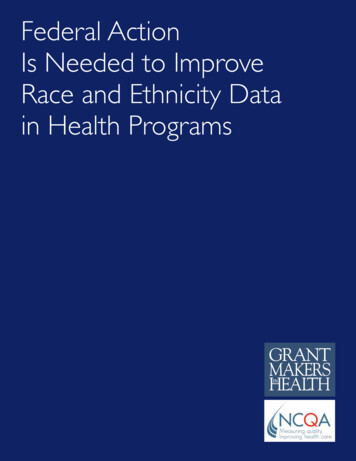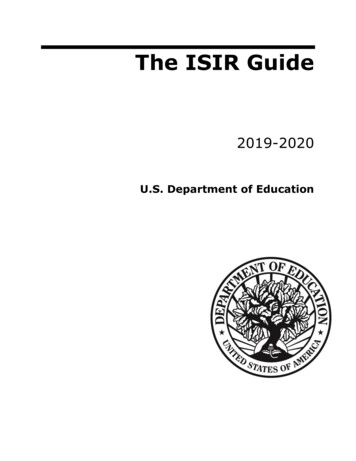
Transcription
Federal ActionIs Needed to ImproveRace and Ethnicity Datain Health Programs
Federal Action Is Needed toImprove Race and Ethnicity Datain Health ProgramsThis project, conducted jointly by Grantmakers In Health (GIH) and theNational Committee for Quality Assurance (NCQA), with support fromThe Commonwealth Fund, includes development of a data framework tocapture how race and ethnicity is collected across federal health programs.A second report, to be released later this year, will lay out short and long-termrecommendations across a range of levers at the federal and state level thatcould lead to better data collection, quality, and usability. The project teamincluded Cara James and Smita Pamar, GIH; Sarah Hudson Scholle,Philip Saynisch, and Jeni Soucie, NCQA; and Barbara Lyons, consultant.2
FEDERAL ACTION IS NEEDED TO IMPROVE RACE AND ETHNICITY DATA IN HEALTH PROGRAMSGIH NCQAGIH.ORGExecutive SummaryThe COVID-19 pandemic laid bare the inequities in health and health care in the U.S., but thelack of adequate data on race and ethnicity prevented an effective response. Urgent action isnecessary to improve race and ethnicity data in federal health programs that serve millionsof Americans. Such data are pivotal to providing access to care, mounting effective and timelyresponses to health crises, eliminating racial and ethnic disparities, and advancing health equity.This paper presents findings and recommendations based on an environmental scan of selectedhealth programs and over 20 interviews with key informants representing federal, state, andlocal health agencies; commercial insurance plans; public and private health systems; and healthinformation technology experts. Examination of federal and state health care and public healthprograms reveals an absence of complete, standardized, self-identified race and ethnicity datasufficient to monitor equity. Key actions the federal government can take now to improve raceand ethnicity data—and, in so doing, advance health equity—are highlighted below.Recommendations for Improving Federal Race andEthnicity DataTo improve federal race and ethnicity data, the government must makeit a priority. Making complete and accurate race and ethnicity data a priority increases thelikelihood that resources will be allocated to support the effort and that progress will be made.The federal government has multiple levers with which it can effect change. These include butare not limited to rulemaking, guidance, the bully pulpit, technical assistance, and outreach andeducation. The government also needs to provide stakeholders with a clear vision and guidanceon how to achieve that vision.1T he federal government should review and update the Office of Management andBudget (OMB) 1997 Statistical Policy Directive on Standards for Maintaining, Collecting,and Presenting Federal Data on Race and Ethnicity to more accurately reflect thedemographics of the population of the United States and provide flexibility to statesand local governments to capture information reflecting the populations specific totheir communities.2T he Centers for Medicare & Medicaid Services (CMS) should include race and ethnicityon the Medicare Part C & D application.3T he Interagency Working Group on Equitable Data (Data Working Group) shouldreview existing data systems and work through OMB to standardize the collectionand reporting of racial, ethnic, and other demographic data across the federalgovernment (e.g., Department of Agriculture (USDA), CMS, and Health Resources andServices Administration (HRSA) reporting requirements) while providing states, localgovernments, and grantees the flexibility to collect data on other population groupsresiding in their area.3
FEDERAL ACTION IS NEEDED TO IMPROVE RACE AND ETHNICITY DATA IN HEALTH PROGRAMSGIH NCQAGIH.ORG4 T he Department of Health and Human Services (HHS) should review and editprovider data systems to collect information on provider demographics, and work withthe Bureau of Labor Statistics at the Department of Labor to help ensure that thepopulation caring for communities reflects the demographics of those communities.5O MB should require all federal program reports to include data stratified by race,ethnicity, and other demographics where feasible.6H HS should require state and local health departments, Medicaid programs, publichealth, and human service programs to conduct an audit of their race and ethnicitydata to identify information gaps and barriers to completion.7H HS and other departments should support states through technical assistance andfinancial assistance to improve data systems and interoperability, as well as improvedanalytic and reporting capacity.8H HS should develop educational resources on the importance of asking an individualabout their race and ethnicity, and resources on why it is important to answer thequestions and how the information will be used. In addition, HHS should workwith myriad stakeholder groups (e.g., providers, consumer and community-basedorganization, public health, etc.) to disseminate the information.9I nclude community voices in the development and dissemination of materialsexplaining why the information is collected, how it will be used, and why it isimportant to collect.10 C ongress should review and amend as necessary the Health Information Portabilityand Accountability Act (HIPAA), the Family Educational Rights and Privacy Act(FERPA), the Patient Protection and Affordable Care Act (ACA), and other data lawsto encourage the collection and sharing of information across health, human and socialservices, including the justice system.11 I mproving privacy protections of data captured through health apps, such as increasingthe Federal Trade Commission’s (FTC) authorization since they manage the healthapps.In sum, the federal government can invest resources in data system changes and educationand technical assistance for expanding collection and use of race and ethnicity data. It canalso increase incentives to collect and assess these data and, in cases, require that federalprogram participants do so. Finally, by reviewing existing regulation to assess where currentpolicy may restrain (or create the appearance of prohibiting) collection of race and ethnicitydata, the federal government can empower stakeholders to pursue these necessary efforts.4
FEDERAL ACTION IS NEEDED TO IMPROVE RACE AND ETHNICITY DATA IN HEALTH PROGRAMSGIH NCQAGIH.ORGThe pandemic’s toll has galvanized the nation to act. This moment of collective momentumfor change provides a unique opportunity that we have not had before, and we may notsee again. Federal action to strengthen the collection and quality of race and ethnicity datain health programs is foundational to improving the quality of care and achieving equitablehealth outcomes.The COVID-19 pandemic laid bare the inequities in health and health care in the U.S., butthe lack of adequate data on race and ethnicity prevented an effective response. Urgentaction is necessary to improve race and ethnicity data in federal health programs that servemillions of Americans. Such data are pivotal to providing access to care, mounting effectiveand timely responses to health crises, eliminating racial and ethnic disparities, and advancinghealth equity.This paper highlights key actions the federal government can take now to improve race andethnicity data and, in so doing, advance health equity. The findings and recommendationsare based on an environmental scan of selected health coverage programs, federal deliverysystems and public health data and over 20 interviews with key informants representingfederal, state, and local health agencies; commercial insurance plans; public and private healthsystems; and health information technology experts. Achieving health equity requires aholistic approach, addressing the health and social needs of individuals and communities andalso racial inequities. This paper focuses on race and ethnicity data and complements otherefforts underway addressing data needs related to social determinants of health.5
FEDERAL ACTION IS NEEDED TO IMPROVE RACE AND ETHNICITY DATA IN HEALTH PROGRAMSGIH NCQAGIH.ORGWhy is now the time for the federal government totake action to modernize the data infrastructure inhealth programs?The consequences of COVID-19 cannot be ignored. The pandemic provides tragicevidence that the racial and ethnic gaps in health care access, quality, and outcomes documented formore than a century persist. Several months into the pandemic, we did not know who was gettingtested or, when vaccines became available, who was getting vaccinated despite knowing about thedisproportionate impact on Black, Indigenous and other communities of color. These disparities inCOVID-19 infections, hospitalizations, morbidity and mortality, and vaccinations magnify the urgencyto have data that can inform our response to inequities stemming from differences in the socialdeterminants of health, such as employment, food, and housing. The magnitude of the evidencedocumenting ongoing racial and ethnic disparities, when combined with societal resolve to addressstructural racism, creates an opportunity to eliminate disparities and be better prepared to respondto future crises.Missing data means missed opportunities to eliminate health and health caredisparities. When race and ethnicity data are incomplete or inconsistently collected in healthprograms, we limit our ability to recognize, monitor, and tackle health disparities and provide qualityhealth care. Lack of race and ethnicity data in health programs impedes progress on improving thehealth of populations across the U.S. and are particularly severe for small population groups, such asAmerican Indians and Alaska Natives. Multiple reasons are cited for the gaps in race and ethnicitydata, including: a lack of up-to-date data collection standards, old data systems, concern about askingindividuals for the information and misperceptions about what is allowable legally, concern abouthow the information may be used, and, in some cases, failure to request the information. However,missing data obscures our ability to see problems that can be addressed and creates the potential forunintended consequences that perpetuate or increase disparities.The pandemic’s toll has refocused attention on racial equity and galvanizedthe nation to act. As policymakers develop strategies to address the underlying structuralfactors that led to the disparities exposed and exacerbated by the pandemic, we have an imperativeto build on the substantial research base to make progress. The 1985 Heckler Report, the firstnational report to address health disparities, along with subsequent work during the 1990s and2000s laid the groundwork for today’s efforts to advance health equity. This moment of collectiverecognition of racial inequities and momentum for change provides a unique opportunity that wehave not had before and may not see again. The Biden Administration has signaled this as well, withpublic statements like its Executive Order On Advancing Racial Equity and Support for UnderservedCommunities Through the Federal Government. We have an opportunity to take action at the federallevel to address these barriers and to strengthen the collection and quality of race and ethnicitydata in health programs. This work is foundational to improve quality of care and the nation’s health.6
FEDERAL ACTION IS NEEDED TO IMPROVE RACE AND ETHNICITY DATA IN HEALTH PROGRAMSGIH NCQAGIH.ORGWhat is the state of race and ethnicity data in healthprograms today?Federal standards and processes leave critical data gaps. Examination of federaland state health care and public health programs reveals an absence of complete, standardized,self-identified race and ethnicity data sufficient to monitor equity. Although widely used, race andethnicity standards released by the OMB in 1997 do not adequately reflect the demographic diversityof the U.S. population today and have not kept pace with how people self-identify. HHS data standardspublished by the Assistant Secretary for Planning and Evaluation (ASPE) in 2011 more accuratelyreflect the diversity of the population. The Affordable Care Act (ACA) requires these data collectionstandards in national population health surveys for the examination of health and health caredisparities, but their use in federal health programs varies. Table 1 presents a comparison ofthese two standards.Table 1: Comparison of OMB 1997 and HHS 2011 Race and Ethnicity Collection StandardsRace*Ethnicity*OMB 1997HHS 2011WhiteBlack or African AmericanAmerican Indian or Alaska NativeWhiteBlack or African AmericanAmerican Indian or Alaska NativeAsianAsian IndianChineseFilipinoJapaneseKoreanVietnameseOther AsianNative Hawaiian orOther Pacific IslanderNative HawaiianGuamanian or ChamorroSamoanOther Pacific IslanderHispanic or LatinoYes, Mexican, Mexican American, Chicano/aYes, Puerto RicanYes, CubanYes, Another Hispanic, Latino/a or Spanish originNot Hispanic or LatinoNo, not of Hispanic, Latino/a, or Spanish origin* OMB 1997 and HHS 2011 permit the reporting of more than one race; HHS 2011 also permits people to select one or more ethnicity.7
FEDERAL ACTION IS NEEDED TO IMPROVE RACE AND ETHNICITY DATA IN HEALTH PROGRAMSGIH NCQAGIH.ORGWhile the HHS 2011 standards expanded the number of categories, they do notnecessarily provide the granularity needed to reflect individuals’ self-identification and tounderstand differences in service use and outcomes. This is particularly true for certainidentities, including Asians, Native Hawaiians and Other Pacific Islanders, American Indiansand Alaska Natives, and people coming from Middle Eastern or North African countries.Moreover, the HHS standards lack the ability to reflect the diversity of many local areasacross the country. More recent efforts like the Office of the National Coordinator forHealth Information Technology (ONC)’s 2015 Edition final rule incorporate an expandedcode set for race and ethnicity that encompasses over 900 ways of representing racial andethnicity self-identification.The completeness of the data, reflecting the percentage of the population with a recordedrace and ethnicity, varies widely across programs. Imputation methods and probabilisticmodeling are sometimes used to fill these gaps. Some stakeholders observed that whilethese methods can be useful at a population level, they should not be used at the individuallevel because they can lead to faulty conclusions. Imputation methods also are not asaccurate for smaller population groups, including American Indian and Alaska Natives andbecause they do not identify Native Hawaiians and Other Pacific Islanders (NHOPI). Further,the accuracy of current data is unknown for many programs even when data is relativelycomplete. Efforts to assess the validity of race and ethnicity data in federal administrativesources have not been consistently undertaken.Self-identification, considered the gold standard for race and ethnicity data collection, isrecognized by both the OMB 1997 and HHS 2011 standards as the preferred means ofdata collection; however, program administration processes do not require or encourageit. Stakeholders pointed to a number of real and perceived barriers to collecting the data,including lack of incentives or requirements, uncertainty over best practices, and privacyconcerns. Self-reported data may also be collected as part of health care delivery, healthassessment tools, and electronic health records, but practices vary widely. Still, the validityof this information is uncertain and there are not clear processes for sharing data acrosssettings or programs and using data to improve administrative records.When health program data is available by race and ethnicity, these data can convey importantinformation to providers, policymakers, and the public. The ability to analyze health programdata is essential to identifying disparities and population groups at-risk, enhancing accessto care and improving the quality of care. Some race and ethnicity data are available to thepublic or researchers as public-use file (PUFs) or researcher identifiable file (RIF), whileothers are more restricted. Accessing these data resources can also be expensive andtechnologically resource intensive.8
FEDERAL ACTION IS NEEDED TO IMPROVE RACE AND ETHNICITY DATA IN HEALTH PROGRAMSGIH NCQAGIH.ORGThe completeness and quality of federal race and ethnicity data varieswidely across health programs. The federal government plays an essential role inmany health programs, including as an important purchaser of health care services throughMedicare and, in partnership with the states, through Medicaid, as a provider of care throughfederal delivery systems, and in administering several public health databases. As a result, thefederal role in data collection is essential to improving collection, quality and availability of raceand ethnicity data in health programs.Table 2 presents a high-level summary of quality andcompleteness of race and ethnicity data collected at enrollment for selected health programs.Race and ethnicity data are comparatively complete for Medicare beneficiaries, although thereare well documented limitations related to changing data sources and standards over time.Before 1989, Medicare’s Enrollment Database (EDB) relied on data collected by the SocialSecurity Administration (SSA) derived from the Social Security application. Prior to 1980, SSAcollected voluntarily provided race data for the categories White, Black, and Other, with missingdata classified as unknown. In 1980, standards were expanded to include White (non-Hispanic),Black (non-Hispanic), Hispanic, Asian/Asian American/Pacific Islander, and American Indian orAlaska Native. When SSA switched to enrollment at birth, the race and ethnicity informationon birth certificates was not recorded in SSA enrollment records, resulting in missing data forbeneficiaries born after 1989. Despite subsequent steps by CMS to improve the accuracy of therace and ethnicity data, challenges remain for some population groups.Medicaid race and ethnicity data is available through the Transformed Medicaid StatisticalInformation System (T-MSIS). Although all states collect self-reported race and ethnicity duringthe Medicaid application process, the granularity and completeness of the data is highly variabledue to differences in state data collection and reporting processes. HHS provides guidancebut does not require states to use the HHS 2011 standards and questions regarding race andethnicity must be identified as optional. State data collection efforts are further complicatedby lack of alignment of standards across federal health and social services programs, such asMedicaid and Supplemental Nutrition Assistance Program (SNAP). As with Medicaid, the qualityand completeness of race and ethnicity data in Marketplace insurance plans varies considerablystate to state. State-based and federally-facilitated marketplaces (SBMs and FFMs) use differentstandards for collection and reporting and rates of missing data vary widely. Race and ethnicitydata on the commercially insured are mostly incomplete.Federal delivery systems, including the Veterans Health Administration (VHA), Indian HealthService (IHS), and Federally Qualified Health Centers (FQHCs) have high rates of self-identifieddata, but the data’s utility is limited. For example, FQHCs collect robust data from patientsserved, but data reporting is aggregated at the center level and thereby limits opportunities forunderstanding differences in use and outcomes across race and ethnicity groups.A range of federal public health data is collected through vital statistics, surveillance andtracking. Data collection methods vary across these efforts, as does the quality of the race andethnicity data.The federal Immunization Information System (IIS) draws on systems administeredby states, territories, and local governments. The federal system calls for use of the OMB 1997standards, but implementation is uneven with variability in data quality and completeness. Forexample, the race and ethnicity data collected for COVID-19 is improving but is not consistentlycollected by states and reporting standards vary. As of August 2021, race and ethnicity data wereavailable for only 58% of people who have received one dose of the vaccine.9
FEDERAL ACTION IS NEEDED TO IMPROVE RACE AND ETHNICITY DATA IN HEALTH PROGRAMSGIH NCQAGIH.ORGProcesses for data sharing are not standardized across federal programs.Race and ethnicity data that are collected by public programs and health care entities is notconveyed across the system in a standardized way. Within HHS, data sharing and interoperabilityacross programs and agencies is limited. Further, race and ethnicity data does not easily flowbetween HHS and other federal programs outside of HHS, such as SNAP, education, and housing.As a result, some stakeholders noted that race and ethnicity data that is collected can be siloedwithin programs and not easily accessed to fill in missing data across programs or to informdecisionmaking.Even when data are available, there is limited insight into equity. High qualityrace and ethnicity data are fundamental to the ability of the federal government to understand thecauses of health disparities, design effective responses, and track and evaluate progress in reducingdisparities. In public programs, collection of race and ethnicity happens at enrollment but is muchless standardized at other points in care delivery. Medicare Advantage stands out as an area whereit is possible to assess equity in clinical quality and care experiences (although some portion isbased on imputed data). The Consumer Assessment of Healthcare Providers and Systems (CAHPS)surveys capture self-reported race and ethnicity data that has been used to examine equity in careexperiences in Medicare fee-for-service and Medicare Advantage. The CAHPS race and ethnicitydata are used in stratified Medicare Advantage performance reporting by the CMS Office ofMinority Health. This is not true for Medicaid or Marketplace, where federal quality reporting doesnot support equity analyses.As technology advances, federal patient privacy protections may not beadequate. The proliferation of health apps can support the ability of patients to self-identify andprovide their data in private without the need for a face-to-face interaction. However, stakeholdersnoted that while these systems have the potential to empower patients, it is essential that patientsunderstand how their data will be used and be empowered to share, not share or unshare data.Technology start-ups developing new products are not necessarily knowledgeable about equityissues and have competing market pressures to collect and use data. Health systems can bepartners in these education efforts, but the federal government also has a role to ensure thatregulatory safeguards are sufficient to protect patient privacy in this rapidly evolving market.10
FEDERAL ACTION IS NEEDED TO IMPROVE RACE AND ETHNICITY DATA IN HEALTH PROGRAMSGIH NCQAGIH.ORGTable 2: Race and Ethnicity Data Collected at Enrollment in Selected Health ProgramsSETTINGDATA COLLECTIONSTANDARDCOMPLETENESS SELF-REPORTED? DATA AVAILABLEFOR RESEARCH?MedicaidFederally-Facilitated and State-BasedMarketplaces (FFMs; SBMs)Standards havechanged over timeHHS 2011bFFMs HHS 2011;SBMs varyCommercial InsuranceUnknown UnknownVeterans Health AdministrationOMB 1997 Indian Health ServiceBlood Quantum &Tribal Affiliation cUnknown Federally Qualified Health CentersOMB 1997 d dBirth RecordsHHS 2011 e COVID-19 VaccinationsOMB 1997 Unknown Pregnancy Risk AssessmentMonitoring SystemOMB 1997 f MedicareLEGEND: Less complete Varies (by state, collection method, etc.) More complete a Yes NoNOTES:a D ata are obtained by SSA from the parents at birth, but data are not available for most beneficiaries born after 1989 due to SSA procedurechanges.Also includes imputation to improve reporting for Asian and/or Pacific Islanders & Hispanic beneficiaries.b Data categories roll up to OMB 1997 standards.c Limited to data from individuals receiving care at IHS providers; 78% American Indians and Alaska Natives live outside tribal statistical areas.d D ata aggregated at center level.e Based on mother & father self-report.f Extracted from birth certificate.11
FEDERAL ACTION IS NEEDED TO IMPROVE RACE AND ETHNICITY DATA IN HEALTH PROGRAMSGIH NCQAGIH.ORGRecommendations for Improving Federal Race andEthnicity DataTo improve federal race and ethnicity data, the government must make it a priority. There are severalrecent examples of how the government has prioritized health data such as the switch from InternationalClassification of Diseases (ICD) 9 to ICD-10 in 2015, the transition from the Medicaid Statistical InformationSystem (MSIS) to the Transformed Medicaid Statistical Information System (T-MSIS) in 2017 and thereplacement of the Sustainable Growth Rate (SGR) law with the Quality Payment Program (QPP) in 2017.These efforts required significant resources, education, and support. Improving the completeness, quality,and utilization of racial and ethnic data in federal and state programs will require the same effort. Making it apriority increases the likelihood that attention will be paid, resources will be allocated to support the effort,and progress will be made. The federal government has multiple levers with which it can effect change. Theseinclude but are not limited to rulemaking, guidance, the bully pulpit, technical assistance, and outreach andeducation. The current administration has begun to make progress in that direction, as exemplified by actionslike the Executive Order on Advancing Racial Equity and Support for Underserved Communities Through the FederalGovernment, which includes provisions to establish an “Equitable Data Working Group.” Without sufficientdata on race and ethnicity, these efforts will fail to live up to their potential.In addition to making the collection of accurate racial and ethnic data a priority, the government needs toprovide stakeholders with a clear vision and guidance on how to achieve that vision. Many of the stakeholderswe spoke with believe that in the absence of a clear vision and guidance, we will continue to be limited inour ability to identify and understand racial and ethnic health disparities. The following recommendations aregrouped into four categories: Changes in Data Standards and Systems; Incentives and Requirements; Educationand Technical Assistance; and Regulation.Changes in Data Standards and SystemsData systems and standards refer to the tools and procedures used to collect, store, and share race andethnicity data. Stakeholders identified key ways in which the categories used to describe racial and ethnic selfidentification could be updated, and in which the federal government could standardize and modernize how itcollects and shares such data.1 he federal government should review and update the OMB 1997 Statistical Policy DirectiveTon Standards for Maintaining, Collecting, and Presenting Federal Data on Race and Ethnicity tomore accurately reflect the demographics of the population of the United States and provideflexibility to states and local governments to capture information reflecting the populationsspecific to their communities.In 2016, OMB convened federal agencies and sought public comment on proposed changes, such asincluding Hispanic as part of the race options and adding an additional race category for Middle Easternand North African, but never finalized the recommended changes.2C MS should include race and ethnicity on the Medicare Part C & D application.Currently, CMS obtains race and ethnicity on Medicare beneficiaries at the time of enrollmentfrom the Social Security Administration, who obtains the data from an individual’s birth certificate.For most beneficiaries, those categories predate the OMB 1997 Directive. Additionally,beginning in 1990, SSA implemented a new process for issuing social security numbers at birth.12
FEDERAL ACTION IS NEEDED TO IMPROVE RACE AND ETHNICITY DATA IN HEALTH PROGRAMSGIH NCQAGIH.ORGIn doing so, they opted not to include race and ethnicity among the informationrequested. As a result, SSA is not able to provide race and ethnicity data forbeneficiaries born after 1990. The proportion of Medicare beneficiaries enrolled inMedicare Advantage has grown significantly in the past decade to include nearly 40percent of all beneficiaries, and more than 75 percent of Medicare beneficiaries areenrolled in a Part D plan. Collecting the data at enrollment in Part C and D will helpfill the void and allow for data to be collected reflecting the current data standards.Additional recommendations for improving racial and ethnic data in Medicare can befound in a report CMS submitted to Congress in 2017.3 he Interagency Working Group on Equitable Data (Data Working Group)Tshould review existing data systems and work through OMB to standardize thecollection and reporting of racial, ethnic, and other demographic data across thefederal government (e.g., USDA, CMS, and HRSA reporting requirements) whileproviding states, local governments, and grantees the flexibility to collect dataon other population groups residing in their area.The federal government should review all data systems to ensure that whereappropriate, race and ethnicity data are collected, and that the programs and systemsallow for more granular data such as the HHS race and ethnicity data categories. Somestakeholders expressed frustration at the inconsistency across federal programs in theway they require race and ethnicity data to be submitted, and at the limited flexibilityfor more granular categories. For example, the Uniform Data System includes datafrom community health centers and asks re
This project, conducted jointly by Grantmakers In Health (GIH) and the National Committee for Quality Assurance (NCQA), with support from The Commonwealth Fund, includes development of a data framework to capture how race and ethnicity is collected across federal health programs.











